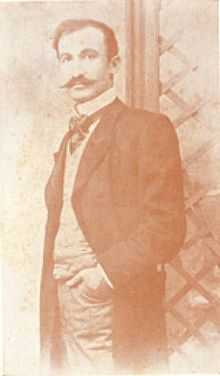Teotig

Teotig in 1905
Teotig (Teotoros Lapçinciyan) (1873; Üsküdar, Constantinople (Istanbul), Ottoman Empire – 1928; Paris, France)[1] was an Armenian writer and publisher known for his Armenian language almanac, Amenun Daretsuytsi (in Armenian Ամէնուն Տարեցոյցը meaning "Everyone’s Almanac").[2] It was published annually between 1907 and 1929.[1][2]
Teotig was born in 1873 to Armenian parents in Üsküdar, a district of Constantinople that is situated on the Asiatic side of the Bosphorus.[2] He married writer Arşaguhi Cezveciyan in 1902.[3] Aside from his yearly Almanac production, Teotig was also known for his "Golgotha of the Armenian Clergy",[1][4] a compilation of sources analyzing the priests, clergymen, and monks who were massacred during the Armenian genocide. He ended up compiling and documenting 1252 witnesses to the massacres of the clergy.[4] Teotig was assisted in his enterprise by his British-educated wife, Arshaguhi Teotig (1875-1921)—herself a writer and educator—until her untimely death. After being forcefully deported during the Armenian genocide, he managed to flee from Constantinople in 1922 on the eve of its occupation by the army of Mustafa Kemal. He lived a wandering life for the next six years, in Corfu, Nicosia, and Paris, with the last yearbooks being printed in Venice, Vienna, and Paris. He died in May 1928 in Paris, when the 18th volume of his yearbooks (his “paper children,” as he called them) was in press. His son Vahakn Teotig died in the United States sometime in the 1960s.[1]
References
 |
Wikimedia Commons has media related to Teotig. |
